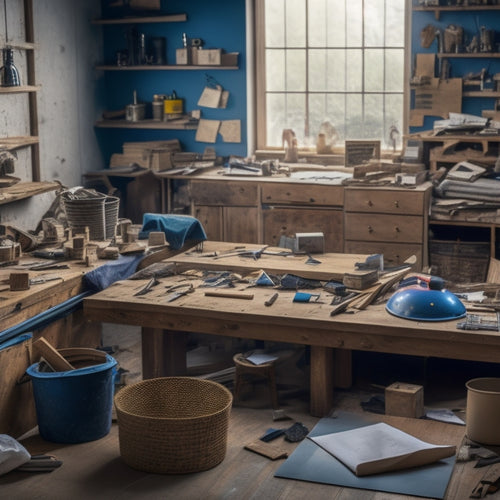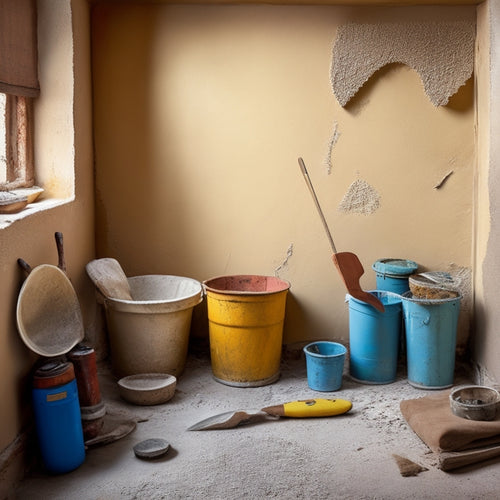
3 Best Affordable Plastering Tools for DIY Renovation
Share
When it comes to DIY renovation, having the right affordable plastering tools can make all the difference. You'll want a putty knife for scraping loose plaster, a joint knife for applying new compound, and a trowel for smoothing out the surface. With these three essential tools, you'll be well on your way to achieving a professional-looking finish. By investing in these quality tools, you'll not only get better results, but you'll also guarantee your tools last longer. Now, take the next step to mastering your DIY plastering skills and uncover the secrets to a flawless finish.
Key Takeaways
• A putty knife is an essential and affordable tool for scraping loose plaster and preparing the surface for DIY renovation.
• A joint knife is ideal for applying new compound at a 45-degree angle to prevent air pockets and ensure a smooth finish.
• A sturdy hawk is crucial for holding and applying plaster efficiently, and is a worthwhile investment for DIY renovation projects.
• A reliable taping knife facilitates quick application of tape to joints, making it a valuable addition to any DIY toolkit.
• Investing in quality tools may seem expensive, but it ensures better results, longevity, and a smoother finish for DIY renovation projects.
Essential Tools for Ceiling Repair
You'll need three essential tools to successfully repair a ceiling: a putty knife for scraping away loose plaster, a joint knife for applying new compound, and a trowel for smoothing out the surface.
Don't even think about attempting a DIY ceiling repair without these trusty sidekicks - you'll end up with a mess on your hands (and on your ceiling). With these tools, you'll be well on your way to mastering ceiling patching techniques and drywall repair tips.
First, use your putty knife to scrape away any loose or damaged plaster. Be gentle, but firm - you don't want to create more holes than you're trying to fix!
Next, grab your joint knife and apply a thin layer of new compound to the affected area. Make sure to hold the knife at a 45-degree angle to avoid creating air pockets.
Finally, use your trowel to smooth out the surface, feathering the edges outwards to blend seamlessly with the surrounding area.
With these tools and a bit of practice, you'll be a ceiling repair pro in no time!
Budget-Friendly Plastering Kit Essentials
When assembling a budget-friendly plastering kit, start with the basics: a sturdy hawk, a reliable taping knife, and a set of mixing buckets and paddles that can withstand heavy use. These essentials will form the foundation of your plastering techniques and help you achieve a smooth finish.
Remember, a good hawk is your right-hand man (or woman) when it comes to holding and applying plaster, so don't skimp on quality. A trusty taping knife will make quick work of applying tape to joints, and those mixing buckets and paddles will be your go-to tools for mixing and applying plaster.
Don't forget to prioritize tool maintenance – a clean and well-maintained kit is essential for achieving professional-looking results. Regularly clean and dry your tools, and store them in a dry place to prevent rust and damage.
Must-Have Tools for Smooth Finish
With your budget-friendly plastering kit foundation in place, next focus on adding specialized tools that'll help you achieve a smooth, blemish-free finish.
You're close to mastering those trowel techniques, but without the right gear, your finishing touches might fall flat.
Here are the must-have tools to take your plastering game to the next level:
-
Finishing trowel: A high-carbon steel trowel with a smooth, flat blade is perfect for applying thin layers of plaster and achieving a glass-like finish.
-
Plaster edger: This handy tool helps you create sharp, clean edges and corners, ensuring a professional-looking finish.
-
Skimming trowel: Designed for applying thin coats of plaster, this trowel is ideal for creating a smooth, even surface that's ready for painting or further decoration.
With these tools in your arsenal, you'll be well on your way to achieving a flawless, showroom-quality finish that'll make you proud.
Remember, practice makes perfect, so don't be afraid to experiment and hone your skills.
Happy plastering!
Frequently Asked Questions
Can I Use a Putty Knife for Applying Joint Compound?
You're wondering if you can use a putty knife for applying joint compound? Absolutely!
In fact, putty knife techniques are perfect for joint compound application. Just be sure to hold the knife at a 45-degree angle and spread the compound smoothly, feathering it out towards the edges.
Don't press too hard, or you'll end up with a mess.
With a little practice, you'll be a pro at joint compound application in no time - and your walls will thank you!
Do I Need a Specialized Tool for Cutting Plasterboard?
You're wondering if you need a specialized tool for cutting plasterboard? Well, let's get to the point - yes, you do!
A utility knife or a plasterboard saw are essential plasterboard tools for clean cuts.
Don't even think about using a putty knife (we've been there, done that).
Mastering plasterboard cutting techniques takes practice, but with the right tool, you'll be a pro in no time.
Trust us, your DIY renovation will thank you.
How Do I Prevent Plastering Tools From Rusting?
You've invested in quality tools, now don't let them turn into rusty relics!
Remember the time your friend Bob left his trowel in the bucket overnight and it was ruined the next morning? Yeah, don't be Bob.
For tool maintenance and rust prevention, make it a habit to wipe your tools dry after each use and store them in a dry place.
Apply a thin layer of oil or silicone spray to metal surfaces for extra protection.
Trust us, your tools (and your sanity) will thank you.
What Is the Best Way to Clean Dried Plaster From Tools?
You've got dried plaster caked onto your tools, and you're wondering how to get rid of it without damaging them. Don't worry, it's a common problem!
The best way to clean dried plaster is to soak the tools in warm water, then use a wire brush to gently scrub off the debris.
For tougher residue, mix baking soda and water to create a paste, and let it sit before rinsing.
Regular cleaning techniques like this will make tool maintenance a breeze, and your gear will last longer.
Are Cheap Plastering Tools Worth the Investment for a Small Project?
Are you willing to sacrifice quality for the sake of a few bucks?
When it comes to plastering, cheap tools might seem like a cost-effective option, but trust us, they're not worth the headache.
Invest in essential toolkits that'll get the job done efficiently, even if it means splurging a bit.
Conclusion
You've got the skills, now it's time to gear up for your DIY plastering project.
With the right tools, you'll be on your way to a professional-looking finish.
Did you know that according to the National Association of Home Builders, 77% of homeowners undertake DIY projects to save money?
With these affordable plastering tools, you can join their ranks and enjoy the satisfaction of a job well done.
Related Posts
-

7 Best Home Renovation Project Checklists With Timelines
You're about to initiate a home renovation project, and establishing a clear plan with timelines is vital to staying ...
-

Why Renovation Waste Disposal Harms the Environment
When you undertake a renovation project, you're contributing to a staggering problem: renovation waste disposal, whic...
-

Stucco Patching Material Checklist for Home Renovation
You'll need a range of essential tools, including a putty knife, wire brush, hawk or flat trowel, level, and straight...


